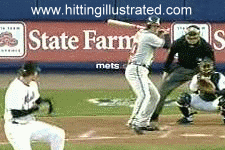quote:
Originally posted by LevelPath19:
Batspeed is not the only factor to consider when developing a swing. Direction of the swing is an equal factor in judging a swing effiency. I coached in college, and one year we measured all of our hitter's batspeeds. Our best hitter was in the middle of the pack, and one of our worst hitters had the fastest batspeed. The good hitter had a very level swing path, coupled with excellent quickness and timing. The poor hitter with good batspeed did not have these skills.
The actual time period of a swing is about .13 seconds. Using Rightviewpro, I have measured most MLB hitters at .13 from initiation to contact. Believe it or not, most amateurs are in this range as well. A typical stride takes around .5 seconds (there is variance) , and the swing .13 (no variance). Since a fastball take .4 seconds to travel to home plate, and the entire process of swinging takes. .65-.7 seconds, all MLB hitters start moving before release. From my experience many amateurs do not start on time, and that is why they struggle as they do.
Good information.
The running start is one of the most misunderstood aspects of the swing.
DMac talked about it all the time.
Check out this hitters running start.

IMO, the lower body dances within the hitters rhythm and is synced with the pitcher's rhythm. Leaving the hands a large window from which to launch.
The key is to learn how to get the barrel moving, in the swing plane, without committing.
In effect, starting, without commitment, yet being able to commit when needed.


